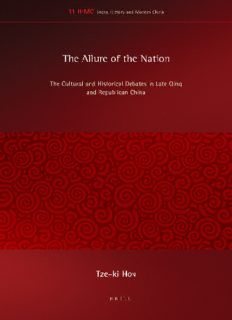Table Of ContentThe Allure of the Nation
Ideas, History, and Modern China
Edited by
Ban Wang, Stanford University
Wang Hui, Tsinghua University
VOLUME 11
The titles published in this series are listed at brill.com/ihmc
The Allure of the Nation
The Cultural and Historical Debates in
Late Qing and Republican China
By
Tze-ki Hon
LEIDEN | BOSTON
This publication has been typeset in the multilingual “Brill” typeface. With over 5,100 characters covering
Latin, ipa, Greek, and Cyrillic, this typeface is especially suitable for use in the humanities.
For more information, please see www.brill.com/brill-typeface.
issn 1875-9394
isbn 978-90-04-29049-5 (hardback)
isbn 978-90-04-29050-1 (e-book)
Copyright 2015 by Koninklijke Brill nv, Leiden, The Netherlands.
Koninklijke Brill nv incorporates the imprints Brill, Brill Nijhoff and Hotei Publishing.
All rights reserved. No part of this publication may be reproduced, translated, stored in a retrieval system,
or transmitted in any form or by any means, electronic, mechanical, photocopying, recording or otherwise,
without prior written permission from the publisher.
Authorization to photocopy items for internal or personal use is granted by Koninklijke Brill nv provided
that the appropriate fees are paid directly to The Copyright Clearance Center, 222 Rosewood Drive,
Suite 910, Danvers, ma 01923, usa. Fees are subject to change.
This book is printed on acid-free paper.
婉瓊
For Wan-Chiung who, over the last two decades,
patiently guided me to self-awakening and self-fulfillment.
∵
Contents
Acknowledgements ix
Introduction 1
Nationalistic Modernity 3
Ti and Yong 5
Nation versus State 6
1 Balancing the Competing Claims in a New Global Order 9
Exhortation to Learning 10
Popular Power 13
Balancing Two Extreme Views 16
The Right Sequence of Learning 19
Social and Economic Reforms 21
Political Reform 24
The Moderate Approach 26
2 Educating the Chinese Citizens 28
The Two-Pronged Approach to Teaching History 30
The Japanese Model 32
The Three Periods 38
The Golden Age 42
Liberation by Returning to the Past 46
3 Sino-Babylonianism before and after the Great War 49
The Origins of Sino-Babylonianism 51
Sino-Babylonianism in East Asia 55
Making Sense of the Distant Past 59
Recovering the Chinese Essence 63
The Hierarchy in Time 65
Mapping the Nation’s Geo-Body 67
Changing Perspectives of the Nation-State System 72
viii contents
4 A Nation of Moderation versus a Nation of Extremes 74
Liu Yizheng’s History of Chinese Culture 76
The Man and His Times 78
Chinese Culture as an Open System 82
The Collective Spirit of the Nation 87
A Nation of Moderation 91
Local Self-Government 93
Centralization and Autonomy 97
5 China’s Cultural and Ethnic Diversity 99
Cultural and Ethnic Plurality 101
Dispute with Dai Jitao 104
Stratification Theory 105
Process versus Telos 107
The Multiplicity and Complexity of Human Events 110
6 A New Aristocracy of the Chinese Republic 113
New Humanism in Early Twentieth-Century America 116
Wu Mi’s New Humanism 118
Aristocratic Democracy 122
Education and Democracy 125
7 Contemporary Meanings of the Sui-Tang Period (581–907) 128
A Biography of Chen Yinke 130
The Dialectics of Opposition and Complementarity 131
China as an Open System 134
China among Equals 136
Land, Family, and Power 138
Matching the Foreign yong with the Chinese ti 140
Conclusion 142
Bibliography 145
Index 165
Acknowledgements
During the fifteen years—from 1992 to 2006—when I was writing the original
articles that form the basis of this book, four of my friends gave me assistance
and guidance that helped me flourish as a scholar.
Mary G. Mazur, my schoolmate at the University of Chicago, exercised her
worldly wisdom in counseling me to follow my instinct, regardless of how
unconventional it might seem. She used her own experience to show me that I
was not alone in treading an untraveled path. She told me that as a woman
entering the field of China studies late in her life, she had encountered many
doubts and obstacles in her research on Wu Han, the famous playwright
wrongly targeted at the beginning of the Cultural Revolution. To make her
point, she reminded me that many people (including Wu Han and his wife
Yuan Zhen) were willing to risk everything for a seemingly unrealistic goal.
Another friend, Peter Zarrow, quietly and patiently nurtured my interest in
the cultural history of early twentieth-century China. Always unassuming and
faithful to friends, Peter has been my critical reader in the last two decades.
Every time I sent him a draft of my paper, days later I would receive lengthy
notes to improve the manuscript. What impressed me was that Peter did not
care whether or not I studied modern China at graduate school; he only cared
about whether I made a coherent argument, gathered sufficient sources to
support my view, and expressed my ideas clearly and cogently. Readers of this
book will have a glimpse of Peter’s selflessness when reading Chapter 1, which
is based on an article in a volume that he and Rebecca Karl edited.
Although much younger than me, Robert J. Culp has acted like an old mas-
ter, skillfully steering me away from abstract ideas to focus on the broad socio-
cultural changes that made modern China unique. We began our friendship
with a discussion of Gu Jiegang at a regional conference in upstate New York.
Quickly our common interest in Gu’s ethnography developed into a decade-
long collaboration in studying the production of knowledge in early twentieth-
century China. Chapter 2 of this book is a testimony to this enduring friendship,
which has profoundly shaped my historical perspective.
In 2007, I had the great fortune to have long conversations with Arif Dirlik in
Amsterdam and Leiden while I was spending the year in Holland. It was under
his influence that I developed a framework to link together various chapters of
this book. While in their original form the chapters of this book were snap-
shots of events in late Qing and Republican China, in their present form they
become episodes of a riveting saga wherein we see the Chinese develop differ-
ent measures to cope with a new global order.

